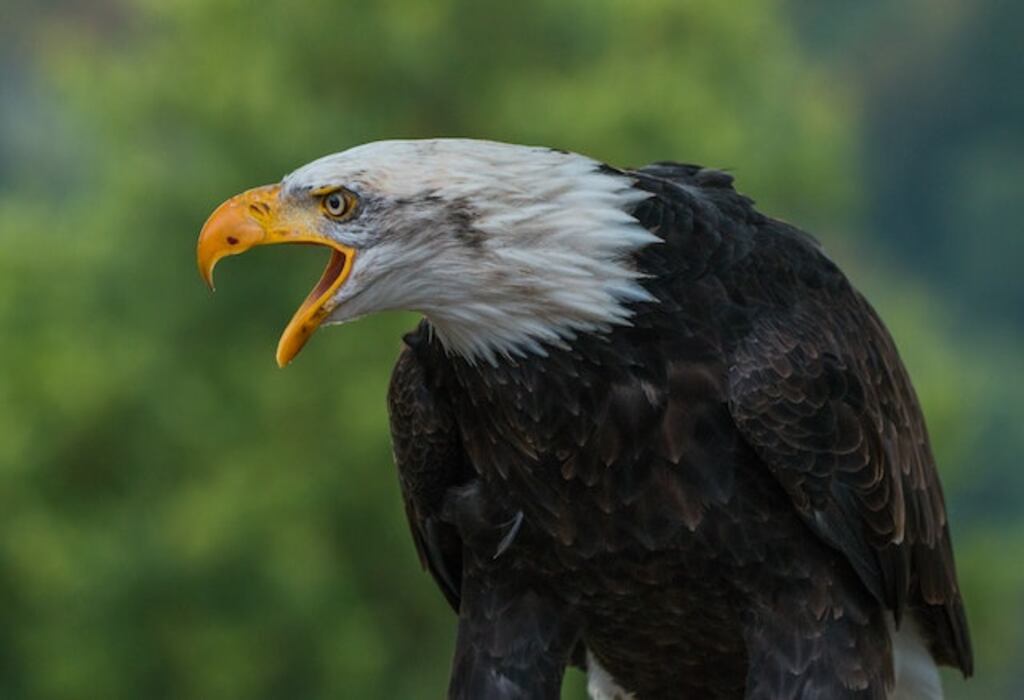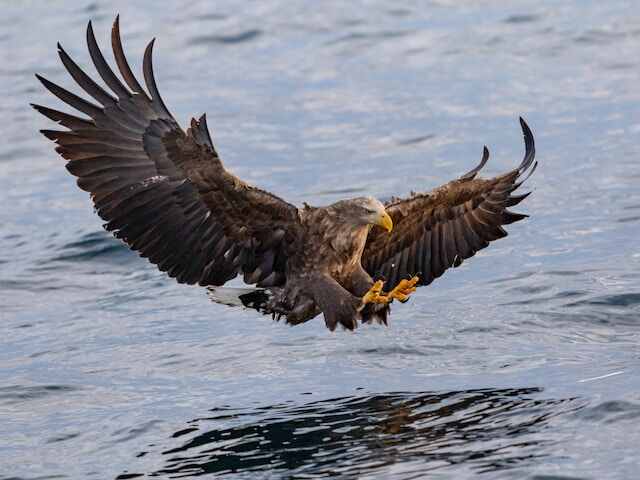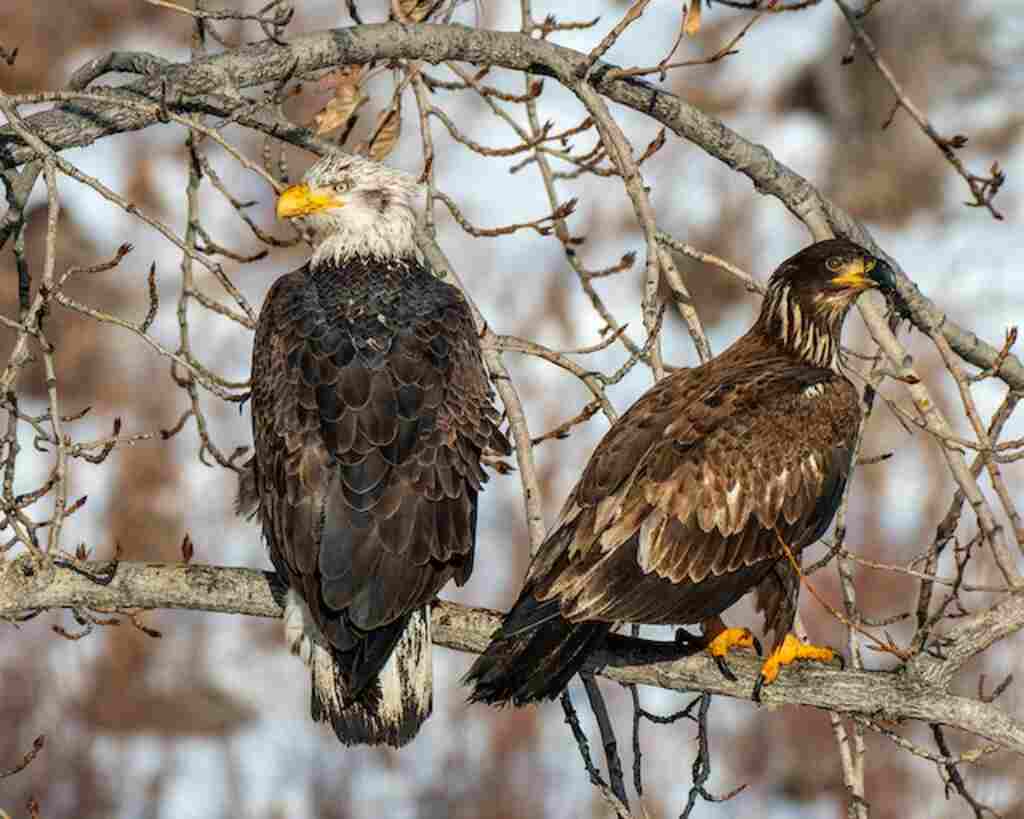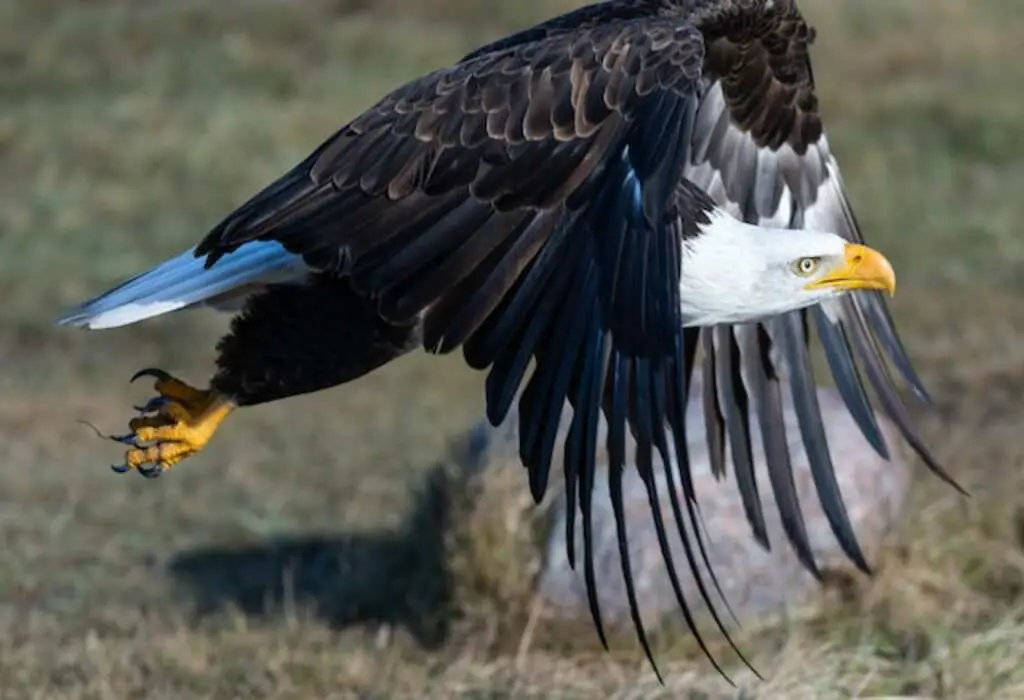Do Eagles Eat Bears? Prepare to be amazed as we dive into the extraordinary world of eagles and explore their predatory prowess.
While bears may seem like formidable creatures, empirical evidence suggests that the diet of eagles does not typically include bears.
Join us as we uncover the intricate dynamics of this relationship, their preferred prey, and the fascinating adaptations that shape the eagle’s hunting habits. Get ready for a wild adventure!
Table of Contents
- 1 The Diet of Eagles
- 2 Common Prey for Eagles
- 3 Factors Influencing Eagle’s Dietary Choices
- 4 Do Eagles Eat Bears
- 5 Size and Strength of Bears as a Deterrent
- 6 Instances of Eagles Scavenging on Carcasses
- 7 Eagle’s Hunting Techniques and Adaptations
- 8 Unlikelihood of Eagles Preying on Bears
- 9 Other Predators in the Bear’s Ecosystem
- 10 Potential Consequences of Eagle-Bear Interactions
- 11 Understanding the Dynamic Nature of Predator-Prey Relationships
- 12 Frequently Asked Questions
- 13 Conclusion
- 14 Author
The Diet of Eagles
The diet of eagles is a subject of interest, as it sheds light on their feeding habits and the role they play in the ecosystem.
Eagles are opportunistic predators, and their foraging habits can vary depending on their habitat and prey availability. They are known to consume a wide range of prey, including fish, small mammals, birds, and reptiles.
Eagles have sharp and powerful beaks, which allow them to tear apart their prey and consume it. They are skilled hunters and often use their exceptional eyesight to spot their prey from high above.
Their impact on local prey populations can be significant, as they are apex predators and can control the abundance and distribution of certain prey species.
However, their hunting behavior also plays a vital role in maintaining the balance of ecosystems by controlling the population of their prey.
Transitioning into the subsequent section about ‘common prey for eagles’, it is important to understand the specific types of prey that eagles commonly target and the ecological significance of their feeding habits.

Common Prey for Eagles
Common prey for eagles includes a variety of small mammals and birds, but what about larger, more formidable creatures?
Eagles are known for their impressive hunting abilities, and they have been observed to successfully target and capture larger prey, such as rabbits, squirrels, and even foxes.
However, it is rare for eagles to prey on bears or other large animals.
This is due to several factors influencing their prey selection and hunting strategies.
Eagles are opportunistic hunters, meaning they are more likely to go after prey that is readily available and easier to capture.
Bears, on the other hand, are powerful and can defend themselves, making them a risky target for eagles.
Moreover, eagles primarily hunt from the air, using their sharp eyesight to locate prey from great distances.
Bears, being terrestrial animals, spend most of their time on the ground, making it difficult for eagles to spot them from above.
Factors such as these influence the dietary choices of eagles, leading to a preference for smaller, more vulnerable prey.
Moving forward, it is essential to explore the various factors that influence the eagle’s dietary choices, including habitat, food availability, and competition, to gain a better understanding of their hunting behavior and ecological role.
Factors Influencing Eagle’s Dietary Choices
Factors such as habitat, food availability, and competition significantly shape the dietary preferences of eagles, providing intriguing insights into their hunting behavior and ecological role.
When it comes to factors influencing eagle’s dietary choices, habitat plays a crucial role. Eagles are found in various habitats, including coastal areas, forests, and open plains.
Each habitat offers different prey opportunities, with coastal areas providing access to marine life, forests offering small mammals and birds, and open plains presenting opportunities for hunting small rodents.
Additionally, food availability is another significant factor that influences eagle’s dietary choices. Changes in prey populations due to factors like climate change can impact the availability of food for eagles.
For instance, rising sea levels and warming oceans can affect the abundance and distribution of fish, which are a primary food source for many eagle species.
Competition is also a vital factor in shaping eagle’s dietary preferences.
In areas with high eagle densities, competition for limited food resources can lead to selective feeding habits, where eagles may target specific prey species that are abundant or less contested.
Understanding these factors is essential for comprehending the dynamics of eagle foraging patterns and their ecological role in different ecosystems.
Transitioning to the subsequent section about the size and strength of bears as a deterrent, it is necessary to explore how eagles navigate their dietary choices when faced with such formidable prey.
Do Eagles Eat Bears
While eagles are known to scavenge carrion, they do not possess the adaptations necessary to hunt and consume live bears.
Eagles primarily prey on smaller animals and fish, and may opportunistically feed on bear carcasses. Their lack of adaptations for larger mammals like bears limits their ability to consume them.

Size and Strength of Bears as a Deterrent
Size and strength are significant deterrents for eagles when considering their dietary choices in the presence of bears.
Eagles are opportunistic predators that typically target smaller prey such as fish, rodents, and birds.
However, when confronted with the size and strength of bears, eagles are less likely to engage in direct predation.
The sheer size of bears can pose a physical challenge for eagles, as they would not be able to overpower or carry them away.
Additionally, bears possess formidable strength, capable of inflicting serious harm on eagles if they were to engage in a confrontation.
Consequently, eagles tend to avoid bears as potential prey and instead focus on smaller, more manageable targets.
This size deterrent and bear strength act as natural barriers for eagles, influencing their dietary choices and preventing them from preying on bears.
However, instances of eagles scavenging on carcasses provide an alternative feeding opportunity for them, which will be further explored in the subsequent section.
Instances of Eagles Scavenging on Carcasses
Instances of eagles opportunistically scavenging on the remains of deceased animals present a unique feeding opportunity that allows them to capitalize on readily available resources in their environment.
Carcass decomposition provides an abundant source of food for eagles, as the decaying flesh attracts a variety of organisms that the eagles can consume.
This scavenging behavior is particularly advantageous in situations where food resources may be limited or competition for food is high.
By scavenging, eagles can avoid direct competition with other predators for live prey and instead focus on feeding on carrion.
Moreover, scavenging on carcasses allows eagles to conserve energy, as they do not have to engage in the physical exertion associated with hunting and capturing live prey.
Additionally, scavenging on carcasses provides eagles with a reliable food source, as they can return to the same location multiple times to feed on the remains.
This behavior also allows eagles to take advantage of the work of other predators that have already located and partially consumed a carcass.
By utilizing their keen eyesight and powerful beaks, eagles can easily tear through the tough hides and flesh of carcasses.
Overall, the scavenging behavior of eagles demonstrates their ability to adapt and exploit available resources in their environment.
Transitioning into the subsequent section about eagle’s hunting techniques and adaptations, it is important to understand how eagles have evolved specific adaptations that enable them to effectively capture live prey.
Eagle’s Hunting Techniques and Adaptations
Eagle’s hunting techniques and adaptations have evolved to enable them to effectively capture live prey, showcasing their remarkable ability to survive and thrive in their natural environment.
The eagle’s hunting behavior is characterized by its exceptional vision, powerful talons, and strong beak.
Their keen eyesight allows them to spot potential prey from great distances, while their sharp talons and strong grip enable them to snatch and immobilize their targets with precision.
Additionally, the eagle’s curved beak is specifically designed to tear flesh and extract meat from its prey.
These physical adaptations, combined with their agile flight capabilities, make eagles formidable hunters.
However, despite their hunting prowess, it is highly unlikely that eagles would prey on bears due to the size and strength of bears, which far exceeds that of typical eagle prey.

Unlikelihood of Eagles Preying on Bears
Unlikely to engage in predation, the dietary preferences of eagles and bears differ significantly, with eagles primarily targeting smaller mammals, birds, and fish, while bears predominantly feed on plant matter, insects, and larger prey such as deer.
For instance, in a study conducted in a forested region, researchers observed that eagles showed no interest in preying on bears, instead focusing their hunting efforts on smaller vertebrates found in the area.
This suggests that eagle-bear interactions in terms of predator-prey relationships are limited.
While bears may occasionally scavenge on eagle kills or disturb their nests in search of eggs, there is little evidence to support the idea that eagles actively seek out bears as prey.
Instead, eagles are more likely to compete with other predators, such as wolves and coyotes, for similar food resources.
Transitioning into the subsequent section about other predators in the bear’s ecosystem, it is important to explore the broader dynamics of predator-prey relationships in the bear’s environment.
Other Predators in the Bear’s Ecosystem
In the complex ecosystem of the bear, various predators coexist, each occupying a specific niche and contributing to the delicate balance of the natural environment.
Predator interactions play a crucial role in maintaining the ecological balance, as they regulate population sizes and prevent any one species from dominating.
Within the bear’s ecosystem, several predators interact with each other, such as wolves, cougars, and coyotes.
These predators compete for similar prey species, but they also have their own unique hunting strategies and preferences.
Wolves, for example, are known to form highly organized social groups and rely on pack hunting, which allows them to take down larger prey.
On the other hand, cougars are solitary hunters that prefer ambushing their prey.
Coyotes, meanwhile, are more opportunistic and adaptable, often scavenging on the remains of larger predators’ kills.
These different hunting behaviors and strategies contribute to the complexity of predator interactions within the bear’s ecosystem, ultimately shaping the delicate balance of the natural environment.
Understanding these interactions is crucial to comprehending the potential consequences of eagle-bear interactions, which will be discussed in the subsequent section.
Potential Consequences of Eagle-Bear Interactions
The potential consequences of interactions between eagles and bears can significantly impact the delicate balance of the natural environment, eliciting a sense of concern for the ecological equilibrium.
When considering the impact of eagle-bear interactions, it is important to focus on the consequences for the bear population.
Eagles are formidable predators, known for their hunting prowess and ability to take down large prey.
If eagles were to prey on bears, particularly cubs or weakened individuals, it could lead to a decrease in the bear population.
This reduction in bear numbers could have cascading effects on the ecosystem, as bears play a crucial role in maintaining balance within their habitats.
For example, bears help disperse seeds through their droppings, which contributes to the growth of plant populations.
Additionally, they play a role in controlling herbivore populations, such as deer, through predation.
Thus, the potential impact of eagle-bear interactions on bear populations raises concerns about the overall stability and functioning of the ecosystem.
Understanding the dynamic nature of predator-prey relationships is crucial for comprehending the intricate workings of ecosystems and maintaining their health and resilience.

Understanding the Dynamic Nature of Predator-Prey Relationships
Understanding the intricate dance between predators and their prey is akin to unraveling a complex web of interdependence in the natural world.
Predator-prey dynamics play a crucial role in maintaining ecological balance, as each species relies on the other for survival.
Here are four key points to consider when examining these relationships:
- Coevolution: Predators and prey constantly evolve in response to each other’s strategies. This coevolutionary arms race leads to the development of new adaptations and behaviors that enhance both hunting and defense mechanisms.
- Population dynamics: The abundance of predators and prey is intricately linked. An increase in prey populations can lead to a rise in predator numbers as more food becomes available. Conversely, a decline in prey populations can result in a decrease in predator numbers due to limited resources.
- Foraging behavior: Predators exhibit various foraging strategies to maximize their hunting success. Some predators, like eagles, may target specific prey species or employ specialized hunting techniques. This diversity of foraging behaviors helps to prevent overexploitation of any one prey species and maintains a balanced ecosystem.
- Trophic cascades: Predator-prey relationships can have cascading effects throughout an ecosystem. For example, if the population of a top predator, such as a bear, declines, it can result in an increase in prey species, which in turn may cause a decline in vegetation due to overgrazing. Understanding these trophic cascades is crucial for managing and conserving ecosystems.
By unraveling the dynamic nature of predator-prey relationships, scientists gain insights into the delicate balance that exists in nature. This knowledge can inform conservation efforts and help maintain the ecological integrity of our planet, ensuring the freedom and stability of all species involved.
Frequently Asked Questions
How do eagles hunt?
Eagles employ various hunting techniques and exhibit specific hunting behaviors. They use their keen eyesight and powerful talons to catch prey, often swooping down from above. Their hunting strategies are efficient and adaptable, allowing them to secure food in their natural habitats.
What are the other predators in the bear’s ecosystem?
Predator-prey interactions in the bear’s ecosystem involve various species. Wolves, cougars, and coyotes are common predators that prey on bears. These interactions play a crucial role in maintaining the balance of the ecosystem.
What are the potential consequences of eagle-bear interactions?
Potential consequences of eagle-bear interactions include changes in the bear’s behavior, such as increased vigilance and altered foraging patterns. These interactions can also have ecological impacts, such as altering predator-prey dynamics and influencing community structure in the bear’s ecosystem.
How do eagles adapt to their hunting techniques?
Eagles exhibit remarkable hunting strategies and adaptations. They possess keen eyesight, powerful talons, and a swift flight that allows them to spot and capture prey efficiently. Their hunting techniques reflect their evolutionary prowess and mastery of the skies.
What is the understanding of the dynamic nature of predator-prey relationships?
The understanding of the dynamic nature of predator-prey relationships involves studying coexistence strategies and predator avoidance. This scientific inquiry explores how different species adapt to minimize conflict and maximize survival in their ecological interactions.

Conclusion
In conclusion, the dietary habits of eagles do not typically include bears. While eagles are formidable predators known for their impressive hunting skills, their diet primarily consists of smaller prey such as fish, rodents, and birds.
Size and strength are crucial factors that deter eagles from pursuing bears as a food source.
Bears, being much larger and more powerful than the typical prey of eagles, pose a significant challenge and risk to these birds of prey.
Furthermore, eagles are more inclined to scavenge on carcasses rather than actively hunt large mammals like bears.
Although there have been rare instances of eagles feeding on bear carcasses, this behavior is more opportunistic rather than a deliberate choice.
It is important to consider the complex dynamics of predator-prey relationships within the bear’s ecosystem.
Bears have their own set of predators and interact with various species in ways that influence their behavior and feeding habits.
Understanding the intricate nature of these interactions is crucial in comprehending the potential consequences of eagle-bear encounters.
While it is unlikely for eagles to prey on bears, their presence in the same ecosystem can have indirect impacts on the bear population.
By keeping the ecosystem in balance, eagles and other predators contribute to the overall health and stability of the ecosystem.
As scientists continue to study and unravel the intricacies of predator-prey relationships, we gain valuable insights into the fascinating world of wildlife dynamics.


